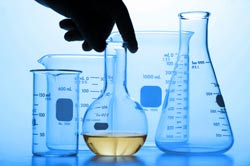Nicholas Piramal Research in India's first public-private drug research project
22 Feb 2008
 Nicholas Piramal Research & Development Ltd (NRDL), and the department of biotechnology (DBT), have signed the country's first public-private drug discovery agreement.
Nicholas Piramal Research & Development Ltd (NRDL), and the department of biotechnology (DBT), have signed the country's first public-private drug discovery agreement.
NRDL was created from the demerger of Nicholas Piramal's NCE Research Unit and its shares will be listed on the BSE and NSE shortly.
The project envisages a mega-scale screening programme for various environmental isolates and is the first project in the country in which industry and academia will work together to screen such a large number of bacterial isolates.
DBT recently initiated a network project, "screening for bio-molecules from microbial diversity collected from different ecological niches". This public-private partnership project involves nine institutes, with NRDL, Mumbai, as an industrial partner.
Different academic institutes will isolate organisms specific to diverse ecological niches. For each sample, isolation of bacteria will be carried out on 30 different growth media.
The total cost of the project is estimated at Rs25 crore, of which DBT is contributing Rs18 crore and NRDL Rs7 crore.
The participating institutes are:
- National Environmental Engineering Research Institute (NEERI), Nagpur
- National Centre for Cell Science (NCCS), Pune
- Institute of Genomics and Integrative Biology (IGIB), Delhi
- University of Delhi, South Campus (UDSC), Delhi
- Institute of Life Sciences (ILS), Bhubaneshwar
- M S Swaminathan Research Foundation (MSSRF), Chennai
- Guru Nanak Dev University (GNDU), Amritsar
- Institute of Bioresources and Sustainable Development (IBSD), Imphal
- National Institute of Oceanography (NIO), Panjim
Each of these institutes is an expert in niche areas of microbial biodiversity and will study the biodiversity of microbes for potential medicinal properties. The microbial isolates have so far not been tested for potent medicinal properties, if any.
This multi-institutional effort will generate approximately 7000 isolates / month (~1000/institute), which will be regularly sent to NRDL, the industrial partner of the project.
This will help in identifying specific therapeutic properties that may be further used to identify novel molecules, which may then be passed on to the drug development phase.
A separate microbial repository is being set up at National Centre for Cell Science (NCCS), Pune to maintain the 2,00,000 isolates generated under this project. This would be the largest such facility in the country and would confirm to International Depository Authority (IDA) standards.
Demand for new and more effective antibiotics continues to grow particularly as bacterial resistance to existing antibiotics spreads. The market for antibiotic drugs is huge. In 2005, worldwide sales of oral antibiotics totaled $25 biillion including US sales of $8.5 billion ($7.0 billion for adults and $1.5 billion for children). Apart from being huge, the market is also growing at a significant rate, with adult and paediatric prescriptions growing in 2005 at 8.5 per cent and 10.8 per cent respectively.
At NRDL's facility at Goregaon, Mumbai, a team of scientists has been concentrating its skills and the company has established high-end technologies using high-throughput robotics, which help in identifying specific properties that can be further developed.
Most biological assays involve the use of living cells under in vitro conditions to measure the therapeutic potential of the extract. If this is found to be positive and better than the existing controls, a collective decision may be taken to move forward to the various steps involved in the development phase of the drug.
Natural diversity appears to be a novel source for new drugs worldwide. In the pursuit of new drug development, new drugs are needed so that an effective pipeline of molecules is established whose properties can be effectively validated in vitro using modern techniques in proteomics and genomics.
Screening will be carried out for anti-cancer, anti-infective, anti-diabetes and anti-inflammation properties. In addition to the culture-dependent method, the culture-independent approach will also be adopted for a few selected samples.
There are hopes that a bank of novel leads with specific potential will soon be developed. This will aid In the long-drawn process of drug discovery.
The project will lead to the selection of potential candidate molecules, which will be taken to process scale-up strategies with appropriate partners. The credit-sharing in this project amongst the PI and industry has been mutually worked out."






























